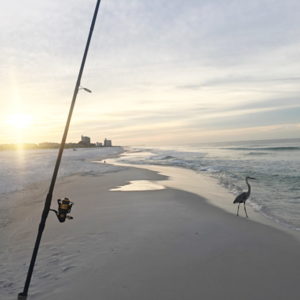*As an Amazon Associate I earn from qualifying purchases.
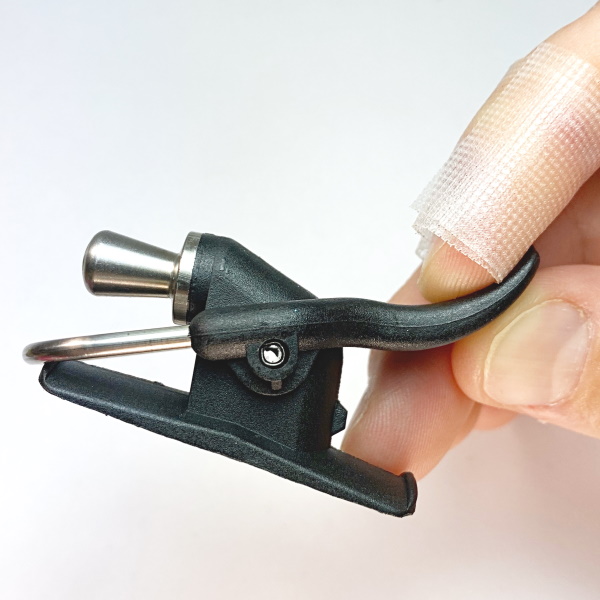
Let’s face it, surf casters often have to deal with the hassle of braided line cutting their finger. That’s not to say it doesn’t happen to freshwater anglers, but it’s far more common with beach fishing.
The culprit is a combination of several things. When you combine a spinning reel with braid, and then add in a heavy payload over 4 ounces, you have a finger slicing machine. Add in some skin softening from hours of water logged fingers, or poor casting technique, and watch out! Make one mistake, and you’re dealing with nasty cut.
Let’s explore more about why it happens, and how we can stop braid from cutting your finger when fishing with a spinning reel.
Why Braided Line On A Spinning Reel Cuts Your Finger?
If you pose this question to the freshwater community, they’ll often jump in with accusations of poor technique. While that’s sometimes true, as technique does matter, that’s not the whole story.
Below are 5 aspects, that when combined in any number of sequences, can cause a nasty cut when using braided line on spinning reels.
- Using a spinning reel
- With braid, particularly thinner braided line
- Having a heavy payload
- With improper technique
- And water logged fingers
How To Stop Braid From Cutting Your Finger
Just one braid cut in an outing really puts a damper on the whole fishing trip. Besides general discomfort, an injured finger can cause you to miss fish. So, we need to do what we can to prevent such an injury in the first place.
There are several things you can do to eliminate this problem. The most common is to use some sort of tape to protect your index finger during the cast. I’ll discuss that, and all the other commonly used options below.
5 Best ways to prevent cuts from braided fishing line
- Tape your finger (most popular)
- Install a Breakaway Cannon (my preference)
- Use a glove or finger guard
- Set your drag properly
- Improve your technique
If all else fails…. 😉
- Fish all the time until you develop epic calluses
- Or, swap over to conventional gear
- Or, stop using braid
1. Tape Your Finger To Prevent Braid Cuts
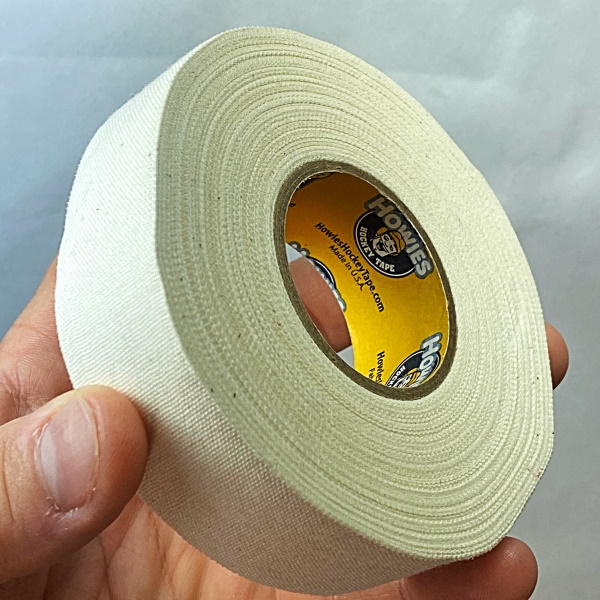
The most common option to prevent cuts is to tape your casting finger.
There are several good tape options, but it’s best to avoid cheap stuff. Cheap tape tends to come off easily when it gets wet. If the tape keeps falling off, you’ll eventually resort to using your middle finger as the casting finger. Guess what happens then…a 2nd cut finger.
I’ve always used waterproof medical tape, but I recently discovered that another good tape for surf casting is hockey tape.
3 Taping Options
Hockey Tape – This is one of the most commonly used tapes for preventing cuts.
Clear Medical Tape – Waterproof medical tape works great as well. It’s cheap, water resistant, and durable.
Electrical Tape – While this works for some folks, it’s not my preference. If you didn’t plan ahead, this option will be better than nothing.
How To Tape Your Finger
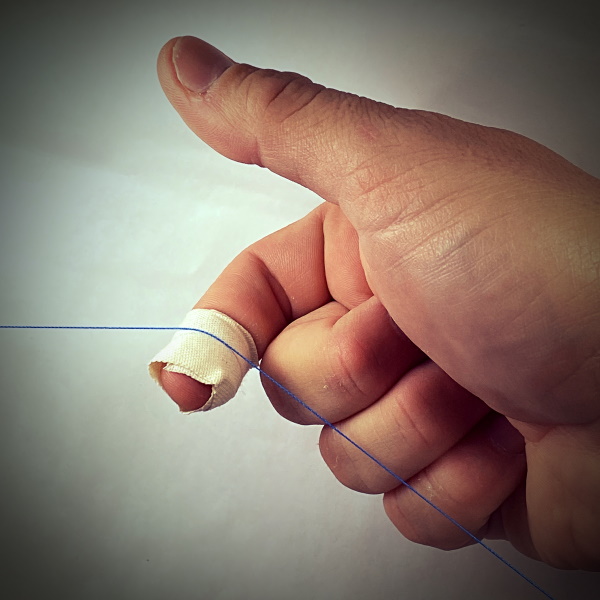
Simply wrap the tip of your index finger on your trigger hand with 1 1/2 to 2 wraps of tape. That is plenty tape to protect your finger, while still allowing a fair amount of sensitivity. If you wrap too much more than that, you’ll completely deaden all sensitivity in the fingertip.
2. The Breakaway Cannon Prevents Cuts
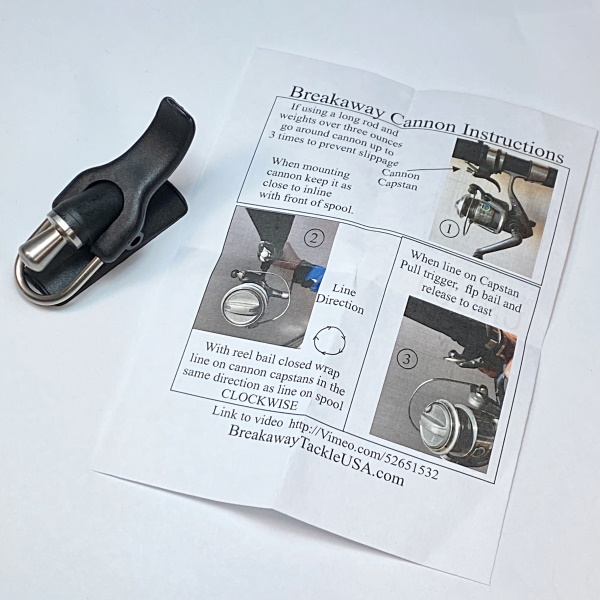
The Breakaway Cannon is a device that you mount to your rod using tape or zip ties. Electrical tape is the better option.
The Breakaway Cannon basically replicates what your finger does when casting a spinning reel. But, instead of your finger releasing the actual line, your finger is releasing the trigger of the Cannon. This in turn is what releases the line.
To use, simply wrap your line once or twice around the Cannon’s knob, and depress the trigger to hold the line there. For lighter payloads you can wrap it once. With heavier weight, you’ll want to use 2 or 3 wraps.
During the cast, release your finger as you normally would. With the Breakaway Cannon, your finger isn’t actually in contact with the line. So, there is no way for you to get cut.
The Cannon does slightly change the timing of the cast, so there is a minor learning curve involved.

* Click image above to view prices on Amazon
Some anglers like to mount the Breakaway Cannon at a 45 degree angle as opposed to directly inline, as the directions suggest. This provides additional casting distance. There are some Youtube videos out there explaining this.
3. Using A Glove Or Finger Guard
A lot of people don’t like to deal with gloves when they’re fishing, me included. I find them to be generally uncomfortable when casting and retrieving.
If you decide to go the glove route, the best option is an AquaSkinz Finger Shield. Aquaskinz are reinforced with Kevlar, so they will not shred to pieces like other glove options are prone to do.
Other anglers will use a set of mechanics gloves, or something similar, and cut off all the fingers except the casting finger. The problem with these is the gloves are not cheap and they will shred from the braid much more quickly than AquaSkinz.
The possibilities for a finger protector are near endless. Here are a few other examples of what surf casters commonly use – archery glove, leather finger guards, cut off fingers of a dish washing glove, a piece of 10-speed bike inner tube, etc.
Regular gloves won’t last very long in a heavy weight surfcasting scenario. Braid will eventually eat through the fingertip, and you’ll be left with gloves that have 9 good fingers, and one that’s worn through. So, if you go the glove route, don’t buy a pricey set of gloves. Instead, buy something fairly cheap. Or better yet, get some AquaSkinz, as the fingertip is reinforced with Kevlar, and thus will last much longer.
4. Set Your Drag Correctly
One of the reasons you could get cut during a cast is an improper drag setting. If your drag is set too loose, it may slip during the cast and cut you.
Tightening your drag down on the cast and then loosening it up afterwards will help in warding off any slippage. Don’t forget to loosen your drag afterwards!
When casting heavy weight, your drag can slip during the cast if you don’t tighten it down. Just always remember to loosen the drag after the cast. Otherwise, you may get snapped off by a fish, or worse, you might see your rod jerked out of a sand spike and dragged into the sea.
5. Improve Your Technique
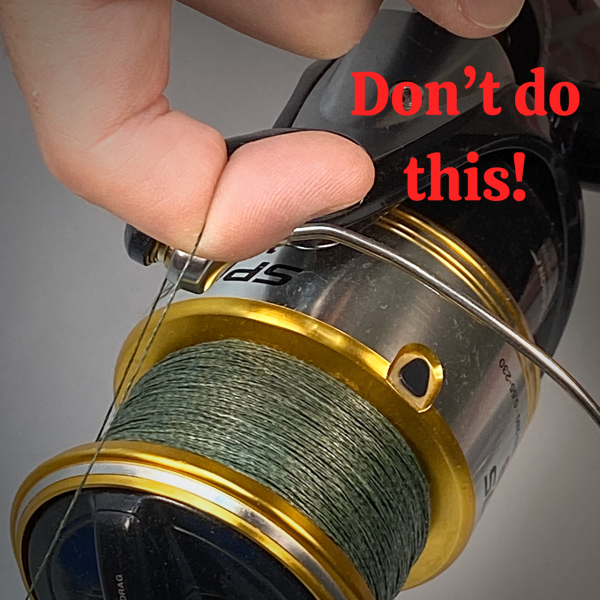
When casting heavy lures or baits you want to keep the braided line on the pad of your fingertip.
It’s almost a natural inclination to grab the line with the joint of your index finger. That’s a big no no. Try to keep the line out of that crease, as the skin is much more sensitive there.
You also want to make sure to time your cast properly. As long as your drag is set properly, you should be able to avoid cuts, if you let go at the right moment. If you release the line slightly earlier in the cast, that will help prevent a cut.
It’s very tempting to push the limits of your casting distance. But, when you put too much into a cast that’s holding back a lot of weight, you are much more apt to slice yourself on the release.
6. Build Up A Callus
If you fish often, you may eventually build up calluses that will help protect your finger from damage. Truthfully, you would have to fish a tremendous amount for that to happen. And even then, rough calluses can be sliced with one errant cast. For most of us, we need something more than a callus to protect us.
What To Do If You Get Cut By Braided Fishing Line
If you do happen to slice your finger while fishing with braided line, you’ll have to deal with it somehow. Stopping fishing obviously isn’t an option.
You can either tape it the best you can, or you can use some type of liquid bandage. It’s better to seal a cut with an actual “liquid bandage” rather than to use the old school Super Glue method. The use of Super Glue in closing wounds dates back to the Vietnam War, and it does work. But, the chemical in it can damage skin tissue. It’s better to use an FDA approved option. Dermabond is one that comes to mind, but there are many others under different names. Search for “liquid bandage” to find some options.
Conclusion
Spinning reel braid cuts are very common in heavy surfcasting applications, but they can definitely be prevented. It’s hard to go wrong with a little waterproof tape, or the Breakaway Cannon. Those 2 options should all but eliminate this issue for you.
Hopefully the tips above save you some discomfort on future outings. If you’d like to learn more about saltwater fishing, check out some of the other articles in my saltwater section, such as this one – What Is An 8NBait Rod?
Happy Fishing
Augustus Clay

